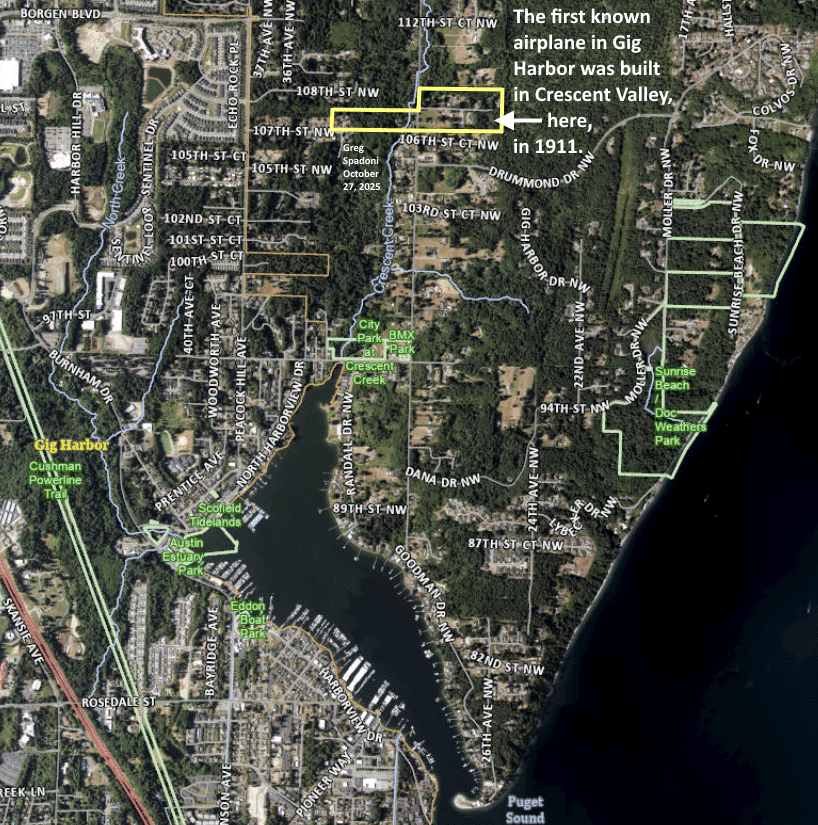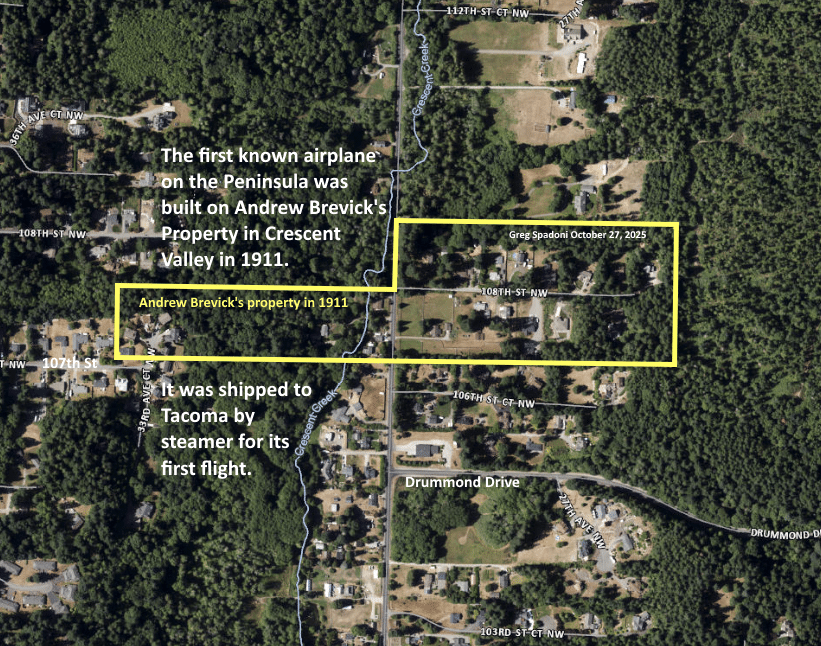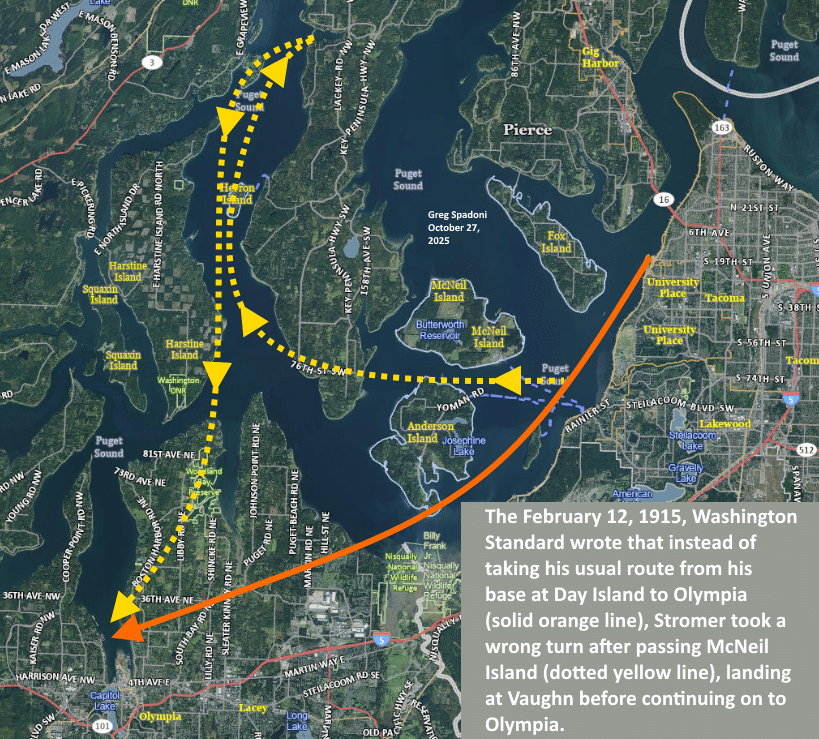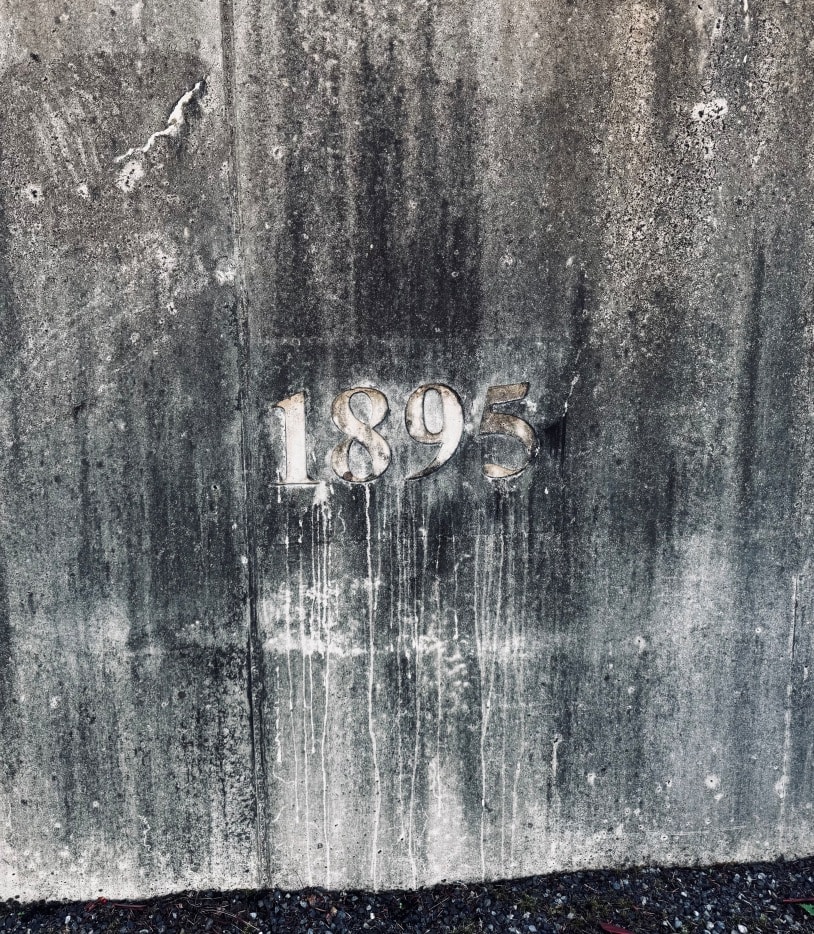Arts & Entertainment Community
Gig Harbor Now and Then | Meet the Swede who pioneered flight on the peninsula
Early Peninsula aviation answers
Our previous column asked four questions about the beginnings of aviation on the Peninsula. Today’s column has four answers.
When was the first aeroplane built on the Peninsula?
Answer: The first aeroplane built on the Peninsula was probably in 1911. No earlier mentions could be found. Considering that the first powered airplane flight in the state of Washington was in 1910, the timing is right. That demonstration at the Meadows Race Track in Seattle no doubt fired up the imagination of many who witnessed it, launching a number of early aviation hobbies and careers.
Who was the builder of the first aeroplane constructed on the Peninsula?
Answer: This is a case of circumstantial evidence. The News Tribune said it was a man named Stone, but that, in all likelihood, was a misspelling. It was all but certainly Gustav Stromer.
Stromer was one of only a small handful of local budding aviators mentioned in Tacoma newspapers at the time, and none of them were named Stone. It is a fact that Stromer lived in Gig Harbor in 1911, and he was manufacturing and selling aeroplane parts there. He was also taking orders for custom-built aeroplanes and gliders. This is his classified ad in the February 16, 1911, edition of The Tacoma Daily Ledger:
AEROPLANES and gliders built to order; gliders mounted on bicycle chassis a specialty; adjustable stay braces, separate parts of all kinds; all kinds of experimental work; prices reasonable. G. W. Stromer, mechanician, Gig Harbor, Wash.

Gustav Stromer’s 1911 ad for aeroplanes and parts while living in Gig Harbor appears to have run only twice, on consecutive days.
After running for only two days, his ad was never seen again. Could it have been so successful that he had all the work he could handle? Or were his finances stretched so thin that two days was all he could afford?
Where on the Peninsula was the first aeroplane constructed?
Answer: If 1911 is indeed the correct year, which it seems to be, then it was built in Crescent Valley, at the home of Andrew Brevick.

The assumed first aeroplane built in Gig Harbor was shipped to Tacoma for its first flight, as reported in the Gig Harbor news column in the April 30, 1911, Tacoma Daily Ledger.

Pierce County Assessor-Treasurer aerial base map.

It was on Andrew Brevick’s property that the first known airplane on the Peninsula was constructed. It was shipped to Tacoma by boat for flying. Pierce County Assessor-Treasurer aerial base map.
What appears to be the first aeroplane built on the Peninsula did not take flight there, but was shipped to Tacoma by steamer for takeoff. The Tacoma Times reported that Gustave Stromer flew his new aeroplane five weeks later, south of Tacoma.
While all the circumstantial evidence points to that flight being made with the airplane built in Crescent Valley, it is not a certainty.
An aeronaut is born
Gustave Stromer was born in Sweden in 1885. He arrived in America at age 15 and worked as a mechanic at the maintenance shops of the Northern Pacific Railroad in South Tacoma before the dream of flying consumed his thoughts.
After his apparently short stint in Gig Harbor, he opened an aeroplane workshop in Tacoma under the name of Tacoma Aeroplane Manufacturing Co. He soon moved his operations to Day Island, across the Narrows from today’s airport at Gig Harbor, Tacoma Narrows Airport. There he concentrated on designing, building, and flying hydro-aeroplanes, which used water for taking off and landing. This photograph, in the collection of the Harbor History Museum, shows him standing on one of his hydro-aeroplanes, a pusher bi-plane, in 1914.

Gustav Stromer’s Tacoma Aeroplane Mfg. Co. advertisement in the October 25, 1911, Tacoma Daily Ledger.
Vaughn by accident
Although Stromer didn’t take off from Gig Harbor with his new aeroplane in 1911, he may have flown one of his hydro-aeroplanes to and from Gig Harbor, as his base at Day Island is only a short hop away. According to the February 12, 1915, Washington Standard, he did land and take off from the Key Peninsula. While heading to Olympia from Tacoma, on a route he’d taken several times before, the newspaper reported that “Stromer lost his way, taking the wrong turn after passing McNeil’s Island and landing first at Vaughn.”
Could that be true? Vaughn isn’t between Tacoma and Olympia. Traveling from Tacoma to Olympia, you don’t make any turns after passing McNeil Island, you keep going in a generally southwestern direction.

Having made the flight many times previously, it’s difficult to believe that Stromer ended up in Vaughn while trying to reach Olympia. Pierce County Assessor-Treasurer aerial base map.
An aeronaut is dead
The 6-foot-2, 205-pound Stromer — who went by many first names, including Gustave, Gus, George, and Walter — was almost killed in a crash while performing a demonstration for the U.S. military in 1918. Early news reports said he wasn’t expected to survive, but he did. He returned to Tacoma to recuperate.
His aviation career appears to have ended with his 1918 crash. From Tacoma he moved to Portland, Oregon, where he worked in cabinet making and furniture repair to earn a living in the early 1920s. He died there at age 39 in 1924.
Although Stromer had at least one very serious flying accident (weren’t all early airplane crashes actually landing accidents?), aviation didn’t kill him. It was an all-too-familiar disease that did him in, tuberculosis. His obituary, though, said that he never fully recovered from his injuries from flying (and crashing).

Gustave Stromer’s obituary was published in the November 23, 1924, Sunday Oregonian.
Here’s a little more on Gustave Stromer, on his Find a Grave page. Click on the right-pointing arrow to see seven images.
Where was the spot that Charles Trombley wanted to see an airfield built on the Gig Harbor Peninsula in 1928?
Answer: To review, here is the entire text of Trombley’s August 10, 1928 editorial:
Aeroplane Landing for Gig Harbor
The time is now at hand when every live community should provide a suitable place as a landing field for aeroplanes. Gig Harbor has a spot that can easily be put in shape for such a purpose and that spot is the ten acre tract which the South Side Club owns and a part of which is now being used as a camp ground. This piece of land is well located for a landing field. However, it will have to be improved and put into shape. It will take some public spirited effort, including a little hard work, but the task is easily within our ability to perform and we believe the matter should be considered seriously at once. Gig Harbor should be able to advertise, among its other advantages, the fact that it has a good landing field for flyers, all of which would give us added prestige and put us on the map in larger letters.
The 10-acre tract that the South Side Club owned in 1928 is today the dangerous, root rot-infested Grandview Forest Park, immediately east of Gig Harbor’s city hall.

The owner and editor of The Peninsula Gateway, Charles Trombley, claimed this square ten acres would make a fine airport with just a little hard work. Pierce County Assessor-Treasurer aerial base map.
At the time a square 10 acres, it measured 660 feet on a side. That’s not a lot of room, even for 1928 airplanes. Especially when you had to climb quickly to avoid tall trees on neighboring properties. It’s also on a side hill, which reduces its practicality.
By comparison, Vaughan Ranch Airfield, a small private runway in Olalla, is 1,850 feet long, with cleared buffers at each end.
Gig Harbor would get its “aeroplane landing” in 1963 when Tacoma Industrial Airport, above the high bluff along the Narrows on Point Fosdick, was opened. It’s now called Tacoma Narrows Airport.
New business
Last month, Mike McNellis told me about a beautiful sign at one of the Peninsula Light Company substations that almost nobody gets to see because it’s well off the nearest public road. It honors one of the Light Co.’s longest serving employees, Oak Lodholm, with most of his 47 years spent as the general manager. I went there, and took pictures. Now lots of people can see it.

Photo by Greg Spadoni.
More new business
This week we have a mystery photograph from Gig Harbor Now columnist Tonya Strickland. It comes with three questions: What is it? Where is it? What does it mean?

Photo by Tonya Strickland.
Next time
The next Gig Harbor Now and Then column will be posted Nov. 17. The subject remains to be determined.
But no doubt it’ll be a good one … right?
Right.
— Greg Spadoni, November 3, 2025
Greg Spadoni of Olalla has had more access to local history than most life-long residents. During 25 years in road construction working for the Spadoni Brothers, his first cousins, twice removed, he traveled to every corner of the Gig Harbor and Key Peninsulas, taking note of many abandoned buildings, overgrown farms, and roads that no longer had a destination. Through his current association with the Harbor History Museum in Gig Harbor as the unofficial Chief (and only) Assistant to Linda McCowen, the Museum’s primary photo archive volunteer, he regularly studies the area’s largest collection of visual history. Combined with the print history available at the museum and online, he has uncovered countless stories of long-forgotten local people and events.

